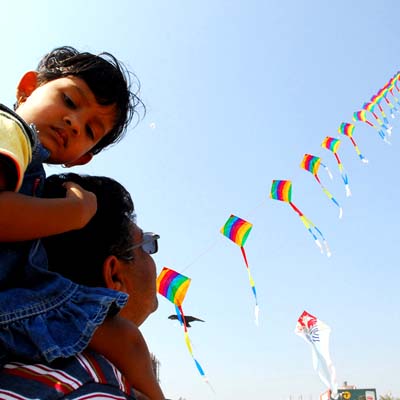
Uttrayan the Kite Flying Festival
The best place in the world to fly a kite, that's India. Flying a kite from the roof is part of everyday life in India. But each year, on Jan. 14, an international kite festival, Makar Sankranti, draws more than 1 million enthusiasts from 36 countries.
Makar Sankranti is one of the most auspicious day for the Hindus, and is celebrated in almost all parts of the country in myriad cultural forms, with great devotion, fervor & gaiety.
Culture & Festivities:
This festival is celebrated differently in different parts of the country.
Gujarat:
In Gujarat Sankrant is observed more or less in the same manner as in Maharashtra but with a difference that in Gujarat there is a custom of giving gifts to relatives. The elders in the family give gifts to the younger members of the family.The Gujarati Pundits on this auspicious day grant scholarships to students for higher studies in astrology and philosophy. This festival thus helps the maintenance of social relationships within the family, caste and community.
Kite flying has been associated with this festival in a big way. It has become an internationally well-known event.
Uttar Pradesh: In Uttar Pradesh, Sankrant is called ‘Khichiri’. Taking a dip in the holy rivers on this day is regarded as most auspicious. A big one-month long ‘Magha-Mela’ fair begins at Prayag (Allahabad) on this occasion. Apart from Triveni, ritual bathing also takes place at many places like Haridvar and Garh Mukteshwar in Uttar Pradesh, and Patna in Bihar. Bengal: In Bengal every year a very big Mela is held at Ganga Sagar where the river Ganga is believed to have dived into the nether region and vivified the ashes of the sixty thousand ancestors of King Bhagirath. This mela is attended by a large number of pilgrims from all over the country. Tamil Nadu: In Tamil Nadu Sankrant is known by the name of ‘Pongal’, which takes its name from the surging of rice boiled in a pot of milk, and this festival has more significance than even Diwali. It is very popular particularly amongst farmers. Rice and pulses cooked together in ghee and milk is offered to the family deity after the ritual worship. In essence in the South this Sankrant is a ‘Puja’ (worship) for the Sun God. Andhra Pradesh: In Andhra Pradesh, it is celebrated as a three-day harvest festival Pongal. It is a big event for the people of Andhra Pradesh. The Telugus like to call it 'Pedda Panduga' meaning big festival. The whole event lasts for four days, the first day Bhogi, the second day sankarati, the third day Kanuma and the fourth day, Mukkanuma. In Andhra Pradesh, it is celebrated as a three-day harvest festival Pongal. It is a big event for the people of Andhra Pradesh. The Telugus like to call it 'Pedda Panduga' meaning big festival. The whole event lasts for four days, the first day Bhogi, the second day sankarati, the third day Kanuma and the fourth day, Mukkanuma. Maharashtra: In Maharashtra on the Sankranti day people exchange multi-colored tilguds made from til (sesame seeds) and sugar and til-laddus made from til and jaggery. Til-polis are offered for lunch. While exchanging tilguls as tokens of goodwill people greet each other saying – ‘til-gul ghya, god god bola’ meaning ‘accept these tilguls and speak sweet words’. The under-lying thought in the exchange of tilguls is to forget the past ill-feelings and hostilities and resolve to speak sweetly and remain friends. This is a special day for the women in Maharashtra when married women are invited for a get-together called ‘Haldi-Kumkum’ and given gifts of any utensil, which the woman of the house purchases on that day. Punjab: In Punjab where December and January are the coldest months of the year, huge bonfires are lit on the eve of Sankrant and which is celebrated as "LOHARI". Sweets, sugarcane and rice are thrown in the bonfires, around which friends and relatives gather together. The following day, which is Sankrant, is celebrated as MAGHI. The Punjabi's dance their famous Bhangra dance till they get exhausted. Then they sit down and eat the sumptuous food that is specially prepared for the occasion. Kerala: The 40 days anushthana by the devotees of Ayyappa ends on this day in Sabarimala with a big festival. Bundelkhand: In Bundelkhand and Madhya Pradesh this festival of Sankrant is known by the name ‘Sakarat’ and is celebrated with great pomp & merriment accompanied by lot of sweets. Tribals of Orissa: Many tribals in our country start their New Year from the day of Sankrant by lighting bonfires, dancing and eating their particular dishes sitting together. The Bhuya tribals of Orissa have their Maghyatra in which small home-made articles are put for sale. Assam: In Assam, the festival is celebrated as Bhogali Bihu In Bundelkhand and Madhya Pradesh this festival of Sankrant is known by the name ‘Sakarat’ and is celebrated with great pomp & merriment accompanied by lot of sweets. Tribals of Orissa: Many tribals in our country start their New Year from the day of Sankrant by lighting bonfires, dancing and eating their particular dishes sitting together. The Bhuya tribals of Orissa have their Maghyatra in which small home-made articles are put for sale. Assam: In Assam, the festival is celebrated as Bhogali Bihu